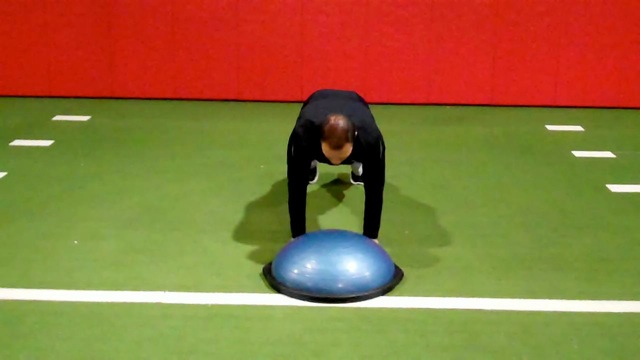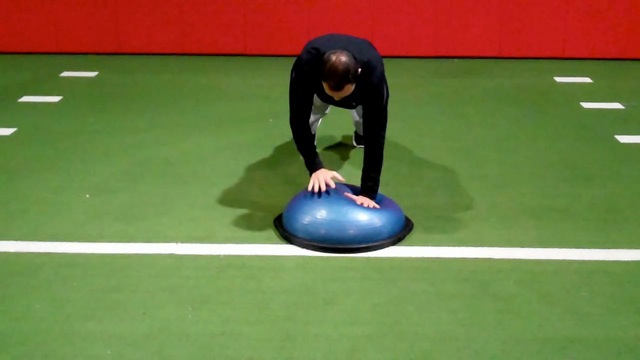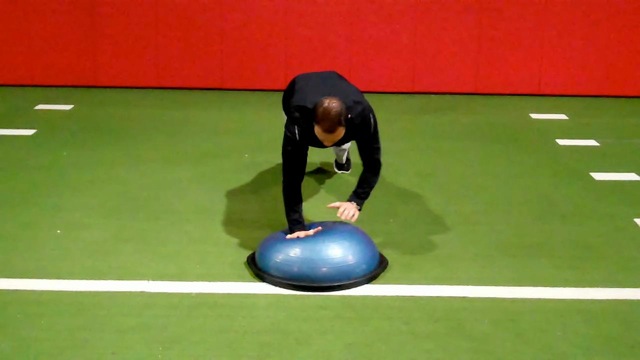
Performing closed chain shoulder exercises is an integral part of training shoulder stability and promoting optimal scapular muscle control. In addition, it provides an opportunity to challenge the stability of the entire kinetic chain.
In the next two columns, I will review two upper extremity closed chain strengthening and stability training exercises I utilize in combination with the BOSU Balance Trainer.
Execution:
Begin in a tall plank position with the feet about shoulder width apart. Next, step-up onto the BOSU Balance Trainer leading with the left hand followed by the right hand. Step back down utilizing the same sequence.
Repeat for 5 cycles and then reverse the order leading with the right hand. The cadence should be slow and deliberate to minimize excessive torso rotation and allow for axial loading through the support arm.
In the next two columns, I will review two upper extremity closed chain strengthening and stability training exercises I utilize in combination with the BOSU Balance Trainer.
Execution:
Begin in a tall plank position with the feet about shoulder width apart. Next, step-up onto the BOSU Balance Trainer leading with the left hand followed by the right hand. Step back down utilizing the same sequence.
Repeat for 5 cycles and then reverse the order leading with the right hand. The cadence should be slow and deliberate to minimize excessive torso rotation and allow for axial loading through the support arm.
 |  |
Consider having the client perform stationary stepping on top of the BOSU Balance Trainer for 5-10 repetitions on each side (no stepping up or down). If this proves too difficult, move to the knees and perform the up and down pattern described earlier. Keep in mind, a client should be able to demonstrate adequate form on a stationary low box prior to advancing to an unstable surface.
 |  |
Application:
This exercise is effective in providing asymmetrical loading through the upper extremity to enhance and challenge shoulder/scapular stability during single and double upper extremity support. The BOSU Balance Trainer also offers a unique balance disturbance as the hand contacts it in an off-center position. I like this added degree of difficulty and uncertainty as sport is often very unpredictable.
Overhead athletes, wrestlers, gymnasts, exercise enthusiasts participating in extreme fitness challenges (e.g. Tough Mudder), tactical professionals and are just a few examples of clientele that may benefit from closed chain unstable upper extremity training.
Progression:
In some instances, it may make sense to perform the exercise with more rapidity if a conditioning response is sought or if the client needs to perform ballistic movement for sport. Be sure to stabilize the BOSU Balance Trainer so it does not slide out from under the client if you choose to attempt this.
Precautions/additional notes:
Be aware that this exercise may not be suitable for clients with limited wrist extension, wrist pain or tendonitis in the wrist, elbow or shoulder. I suggest beginning on the knees if there is any question regarding the client's upper body strength or capacity to safely effectively perform the maneuver.
This exercise is effective in providing asymmetrical loading through the upper extremity to enhance and challenge shoulder/scapular stability during single and double upper extremity support. The BOSU Balance Trainer also offers a unique balance disturbance as the hand contacts it in an off-center position. I like this added degree of difficulty and uncertainty as sport is often very unpredictable.
Overhead athletes, wrestlers, gymnasts, exercise enthusiasts participating in extreme fitness challenges (e.g. Tough Mudder), tactical professionals and are just a few examples of clientele that may benefit from closed chain unstable upper extremity training.
Progression:
In some instances, it may make sense to perform the exercise with more rapidity if a conditioning response is sought or if the client needs to perform ballistic movement for sport. Be sure to stabilize the BOSU Balance Trainer so it does not slide out from under the client if you choose to attempt this.
Precautions/additional notes:
Be aware that this exercise may not be suitable for clients with limited wrist extension, wrist pain or tendonitis in the wrist, elbow or shoulder. I suggest beginning on the knees if there is any question regarding the client's upper body strength or capacity to safely effectively perform the maneuver.
 | Add BOSU to the equation and intensify your training programs. You've trusted BOSU for years, and now we're giving you more reasons to make BOSU an essential part of your fitness and training routines. |
Brian Schiff, PT, OCS, CSCS, is a licensed physical therapist, respected author and fitness professional. Currently, he serves as the supervisor at the Athletic Performance Center in Raleigh, NC. Brian presents nationally at several professional conferences and seminars on injury prevention, rehab and sport-specific training. For more cutting edge training information, subscribe to his monthly Training & Sports Medicine Update at www.BrianSchiff.com.















